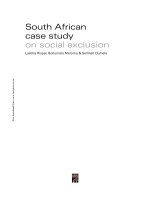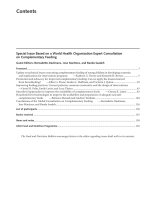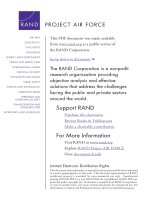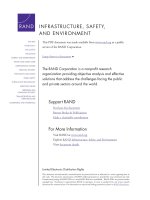Fighter Drawdown Dynamics - Effects on Aircrew Inventories potx
Bạn đang xem bản rút gọn của tài liệu. Xem và tải ngay bản đầy đủ của tài liệu tại đây (1.47 MB, 183 trang )
This document and trademark(s) contained herein are protected by law as indicated
in a notice appearing later in this work. This electronic representation of RAND
intellectual property is provided for non-commercial use only. Unauthorized
posting of RAND PDFs to a non-RAND Web site is prohibited. RAND PDFs are
protected under copyright law. Permission is required from RAND to reproduce,
or reuse in another form, any of our research documents for commercial use. For
information on reprint and linking permissions, please see RAND Permissions.
Limited Electronic Distribution Rights
Visit RAND at www.rand.org
Explore RAND Project AIR FORCE
View document details
For More Information
This PDF document was made available
from www.rand.org as a public service of
the RAND Corporation.
6
Jump down to document
THE ARTS
CHILD POLICY
CIVIL JUSTICE
EDUCATION
ENERGY AND ENVIRONMENT
HEALTH AND HEALTH CARE
INTERNATIONAL AFFAIRS
NATIONAL SECURITY
POPULATION AND AGING
PUBLIC SAFETY
SCIENCE AND TECHNOLOGY
SUBSTANCE ABUSE
TERRORISM AND
HOMELAND SECURITY
TRANSPORTATION AND
INFRASTRUCTURE
WORKFORCE AND WORKPLACE
The RAND Corporation is a nonprofit
research organization providing
objective analysis and effective
solutions that address the challenges
facing the public and private sectors
around the world.
Purchase this document
Browse Books & Publications
Make a charitable contribution
Support RAND
This product is part of the RAND Corporation monograph series.
RAND monographs present major research findings that address the
challenges facing the public and private sectors. All RAND mono-
graphs undergo rigorous peer review to ensure high standards for
research quality and objectivity.
Effects on Aircrew Inventories
Fighter
DrawDown
Dynamics
Effects on Aircrew Inventories
Fighter
DrawDown
Dynamics
PROJECT AIR FORCE
Prepared for the United States Air Force
Approved for public release; distribution unlimited
William W. Taylor
•
James H. Bigelow
•
John A. Ausink
The RAND Corporation is a nonprofit research organization providing
objective analysis and effective solutions that address the challenges facing
the public and private sectors around the world. RAND’s publications do
not necessarily reflect the opinions of its research clients and sponsors.
R
®
is a registered trademark.
© Copyright 2009 RAND Corporation
Permission is given to duplicate this document for personal use only, as long
as it is unaltered and complete. Copies may not be duplicated for commercial
purposes. Unauthorized posting of RAND documents to a non-RAND
Web site is prohibited. RAND documents are protected under copyright law.
For information on reprint and linking permissions, please visit the RAND
permissions page ( />Published 2009 by the RAND Corporation
1776 Main Street, P.O. Box 2138, Santa Monica, CA 90407-2138
1200 South Hayes Street, Arlington, VA 22202-5050
4570 Fifth Avenue, Suite 600, Pittsburgh, PA 15213-2665
RAND URL:
To order RAND documents or to obtain additional information, contact
Distribution Services: Telephone: (310) 451-7002;
Fax: (310) 451-6915; Email:
The research described in this report was sponsored by the United States
Air Force under Contract FA7014-06-C-0001. Further information may
be obtained from the Strategic Planning Division, Directorate of Plans,
Hq USAF.
Library of Congress Cataloging-in-Publication Data is available for this publication.
ISBN 978-0-8330-4695-6
iii
Preface
is monograph documents recent (2005–2008) RAND Corporation
research on combat air force aircrew management problems result-
ing from the competing goals of producing sufficient experienced
combat pilots and operating within the constraints of force structure
reductions.
e monograph summarizes the supply-and-demand problems the
fighter force has faced over the past decade, summarizes the decisions
made in an attempt to solve them, and describes the RAND dynamic
simulation model used to help the Air Force better understand the con-
sequences for fighter units of attempting to maintain high fighter-pilot
production levels while the fighter infrastructure is declining. We use
the model to show the potential unsatisfactory consequences of some
aircrew management polices that were introduced from 2005 to 2008
and then to develop policy options that would enable the Air Force
to maintain a healthy fighter pilot force and address the added com-
plications of the rising demand for fighter pilots in various nonflying
positions.
is research is part of a multiyear study, “Rated Force Manage-
ment,” sponsored by the Air Force Deputy Chief of Staff for Air, Space,
and Information Operations, Plans and Requirements (AF/A3/5). e
study was conducted within the Manpower, Personnel, and Training
Program of RAND Project AIR FORCE. is monograph is designed
to help aircrew managers and analysts support senior Air Force policy-
makers in developing policies that will maintain a healthy fighter pilot
force.
iv Fighter Drawdown Dynamics: Effects on Aircrew Inventories
Readers may also be interested in the following related RAND
documents:
e Air Force Pilot Shortage: A Crisis for Operational Units?• by
William W. Taylor, S. Craig Moore, and C. Robert Roll, Jr.,
MR-1204-AF, 2000.
Absorbing Air Force Fighter Pilots: Parameters, Problems, and •
Policy Options, by William W. Taylor, James H. Bigelow, S. Craig
Moore, Leslie Wickman, Brent omas, and Richard Marken,
MR-1550-AF, 2002.
Absorbing and Developing Qualified Fighter Pilots: e Role of the •
Advanced Simulator, by Richard S. Marken, William W. Taylor,
John A. Ausink, Lawrence M. Hanser, C. R. Anderegg, and Leslie
Wickman, MG-597-AF, 2007.
RAND Project AIR FORCE
RAND Project AIR FORCE (PAF), a division of the RAND Cor-
poration, is the U.S. Air Force’s federally funded research and devel-
opment center for studies and analyses. PAF provides the Air Force
with independent analyses of policy alternatives affecting the devel-
opment, employment, combat readiness, and support of current and
future aerospace forces. Research is conducted in four programs: Force
Modernization and Employment; Manpower, Personnel, and Train-
ing; Resource Management; and Strategy and Doctrine.
Additional information about PAF is available on our Web site:
/>v
Contents
Preface iii
Figures
ix
Tables
xi
Summary
xiii
Acknowledgments
xix
Abbreviations
xxi
Glossary
xxv
CHAPTER ONE
Introduction 1
Organization of the Monograph
2
CHAPTER TWO
How the Crisis in Fighter Aircrew Management Developed 5
e Aircrew Management Problem
5
Complexities of the Aircrew Training and Development System
7
How the Post–Cold War Drawdown Affected the System
7
Four-Star Rated Summit Attempts to Address System Problems
8
Resistance to Realistic Production Limits
10
Factors Complicating Problem Recognition
12
Pipeline Capacities
12
Contingency Support Flying
15
FY 2004 Total Pilot Inventory Match
17
Pilot Shortages in Important Year Groups: e Pilot Bathtub
20
Conclusion
22
vi Fighter Drawdown Dynamics: Effects on Aircrew Inventories
CHAPTER THREE
Modeling the System 23
A Steady-State Picture of Pilot Absorption
23
e Dynamic Picture of Pilot Absorption
26
An Example of the Capabilities of the Dynamic Model
29
Evolution of the Dynamic Model
33
Varying Pilot-Production Rates
33
Allowing Simulator Time to Count Toward Experience:
Model Updates in 2006
35
Another Model Update in 2006: Incorporating Second
Operational Tours
37
New Model Capabilities in 2007: Accounting for Early
Departures
38
e Forever-Unfinished Model
39
CHAPTER FOUR
Air Force Policy Decisions: 2006–2008 41
Aircrew Review 2005
42
Characterizing the Health of Fighter Units
42
Model Results Presented to Aircrew Review 2005
44
e Effects of Crediting Simulator Time and Related AFSO-21
Policy Decisions in 2006
46
Discovery of a Potential Second-Tour Choke Point
48
Operational Units Require Second-Tour Pilots for IPs and
Flight Leads
49
Effects of Related Cuts in Flying Hours
51
e TAMI 21 Task Force: Proposals to Improve Aircrew
Management
52
Model Results Used in Initial TAMI 21 Discussions
53
Projections of the Consequences of Doing Nothing
54
Options for Fixing Fighter Unit Problems Studied by TAMI 21
61
Recommendations of the TAMI 21 Task Force
65
Other Events and Decisions at Followed TAMI 21
69
e Rated Sustainment Working Group
69
e Four-Star Conference
70
Decisions at Followed the 2007 Four-Star Conference
72
Contents vii
Predicted Consequences of the Decisions 74
e Removal of Experienced Pilots Has Little Effect
75
UAS Career Field Revisited
76
Conclusions
78
CHAPTER FIVE
e Potential Role of Total Force Integration Initiatives 81
No Total Force Component Can Be Sustained with Existing
Paradigms
81
Air Force Reserve and Air National Guard Manning Issues
82
A eoretical Upper Bound for Potential AFRC and ANG
Contributions
84
Obstacles to Realizing the eoretical Upper Bound
85
Unit Associations
85
Absorption Capacity Potential in Active-Associate Units
86
Resource Issues for Active-Associate Units
88
What Needs to Be Done?
90
Current Paradigm Obsolete?
90
Revised Directives
92
Alleviating Current Rated Officer Shortfalls
93
Summary
94
CHAPTER SIX
Conclusions and Recommendations 95
APPENDIXES
A. A Model for Dynamically Tracking Fighter Pilots rough
Operational Squadrons
99
B. e 2005 Aircrew Review
137
C. Working Group on Transformational Aircrew Management
Initiatives for the 21st Century
143
References
149
ix
Figures
2.1. Primary Mission Aircraft Inventory for Active-Duty
and ARC Fighters and Fighter-Pilot Production Goals
14
2.2. Aircrew Requirements Versus Inventory
18
2.3. FY 2004 Aggregate Pilot Force Profile by Grade and
Commissioned Year of Service
19
3.1. Example Model Output: Manning of Operational
Squadrons
30
3.2. Example Model Output: Time to Experience for UPT
Graduates
30
3.3. Example Model Output: Sorties Each Inexperienced Pilot
Flies per Month
31
3.4. Example Model Output: “Real” Experience Level
31
3.5. Manning Levels in Cases with Target Manning
34
3.6. Entry Rates Needed to Achieve Target Manning
35
4.1
. Effects of Rated Management Policies Existing in
December 2006
55
4.2
. Training Sorties for Inexperienced Pilots Under Default
Policies
57
4.3
. F-15C and F-16 Pilots Becoming Experienced Under
Default Conditions
57
4.4. Experience Levels in F-15C and F-16 Units
58
4.5. First-Tour Pilots Fill More an 80 Percent of the API-1
Authorizations
59
4.6
. Effects of Reduced Pilot Production on Manning Levels 61
4.7
. Improvements in Available Training for Inexperienced
Pilots
63
4.8
. e 32-Month Time-to-Experience Objective 63
x Fighter Drawdown Dynamics: Effects on Aircrew Inventories
4.9. CAF’s 55-Percent Experience-Level Objective 64
4.10
. First-Tour Fill Rates 64
4.11
. Comparing the Numbers of Pilots Entering Introduction
to Fighter Fundamentals by Fiscal Year Under Two Plans
75
A.1
. Selection of Next Trial Value When HCM Is Oscillating 131
B.1
. Effects of Different Levels of Pilot Production 139
xi
Tables
2.1. e Extent of the Post–Cold War Drawdown 8
3.1. Pilot Production for ree F-15C Cases
29
4.1. Summary of Model Runs for Absorbable Fighters in
December 2005
45
4.2. e Default Model Runs for the TAMI 21 Task Force
Indicate at Every Absorbable Fighter System Breaks
by FY 2015
60
4.3. Summary of TAMI 21 Directed Model Runs
66
A.1. Parameters Usually Provided as Model Inputs
133
A.2. Selected Parameters Usually Produced as Model Outputs
135
xiii
Summary
e Air Force faces an increasing demand for personnel with pilot
skills, a demand driven by the expanding number and size of various
staffs (such as those of air operations centers) and an increased demand
for operators of unmanned aircraft systems (UASs), who, by Air Force
policy, must be pilots.
1
At the same time, the Air Force faces a declining
ability to produce pilots (particularly fighter pilots) because its aircraft
inventory is decreasing: By 2016, there will be fewer than 1,000 fighter
aircraft in the total Air Force inventory (active, Guard and Reserve)—
only 32 percent of the number in 1989. With fewer aircraft, it is dif-
ficult for all pilots to fly enough to maintain their combat skills, and
it is particularly difficult for new pilots to gain enough experience in
their first flying tour to be prepared for follow-on nonflying and flying
positions (pp. 54–60). is has made aircrew management—the pro-
cess of maintaining an aircrew force of sufficient size and readiness to
accomplish the Air Force’s current and forecast mission—particularly
difficult, and without changes to current management policies, the Air
Force will be unable to fill important flying and staff positions.
Our primary conclusion is that, to maintain the health of fighter
units, the number of new pilots entering them must be reduced, ulti-
mately to below 200 per year by 2016. Overabsorption decreases the
number of monthly sorties inexperienced pilots can fly, lowers the aver-
age experience level of fighter units, makes it difficult or impossible
1
Because UAS is the term that refers to the equipment the pilots operate directly, it is the
term commonly used among military pilots and in this monograph to refer to skills, equip-
ment, and operations related to unmanned aerial vehicles.
xiv Fighter Drawdown Dynamics: Effects on Aircrew Inventories
for new pilots to become experienced in an initial three-year tour, and
increases the amount of time a pilot must wait between a first flying
tour and an opportunity for a second one, thus slowing the develop-
ment of the background and experience elements needed to make the
pilot useful in staff or supervisory positions. All these circumstances
can lead to a general degradation of pilot skills and combat capability.
e current situation in fighter units is the result of several deci-
sions made during the Cold War drawdown in Air Force structure
(p. 7). e drawdown resulted in a surplus of pilots, and the Air Force
responded to the surplus by decreasing pilot production in the early
1990s without encouraging the departure of pilots already in the inven-
tory (pp. 7–8). e Air Force also closed down one of its pilot train-
ing bases. By 1996 the fighter force had declined enough to require
increasing pilot production, but the earlier base closure made the
desired increase (almost doubling fighter-pilot production) difficult. In
addition, the low production of the early 1990s meant that a short-
age of pilots in specific skill groups and grades had developed (p. 7).
Partly to address the shortage, but also to meet increasing demands for
pilots in staff positions, a series of four-star level summits from 1996 to
2003 established annual pilot-production goals that remained in force
through 2007: 1,100 total pilots, of which 330 were to be fighter pilots
(pp. 8–10).
In 2005, RAND used a dynamic mathematical model of fighter
pilot absorption capacity (the process of turning a new pilot into an
“experienced” one) to show that attempting to achieve the established
fighter-pilot production goals with the projected aircraft inventory
would severely impair the ability of fighter units to maintain combat
capability and provide the training necessary to produce experienced
pilots (pp. 42–45). Units would have more personnel than they were
authorized for the number of aircraft they had; inexperienced pilots
would not be able to fly the number of sorties they needed to each
month; and new fighter pilots would complete their first three-year
tours without receiving the experience they needed for follow-on flying
assignments or staff tours (p. 45).
ese results, along with the recognition that other policy changes
would affect the health of fighter units, led to the establishment of the
Summary xv
Transformational Aircrew Management Initiatives for the 21st Cen-
tury (TAMI 21) working group in October 2006. Its goal was to find
solutions to various aircrew management problems and present them to
senior leadership. e RAND dynamic model enabled rapid analysis
of the consequences of policy solutions that the TAMI 21 group dis-
cussed. e group’s primary conclusion was that the flow of new pilots
into fighter units must be reduced to a level at which units could absorb
them—about 200 new fighter pilots per year. Using RAND modeling,
the group also showed, however, that the Air Force could still main-
tain an inventory of personnel with the desired pilot skills (and satisfy
emerging UAS requirements) if it implemented several policy initia-
tives (pp. 52–67).
After a four-star level aircrew management conference in March
2007, the Air Force implemented a much-revised version of the TAMI 21
recommendations. e most important decision was an attempt to
simultaneously meet increased demands for UAS pilots and decrease
the overmanning of fighter units by transferring a limited number of
inexperienced pilots from fighter units to UAS aircraft before they had
completed their first three-year tour. Unfortunately, RAND model-
ing showed that, while this decision led to short-term improvements
in F-16 and F-15C fighter units, it would still be necessary to make
long-term reductions in the flow of new pilots into these units to keep
them from becoming “broken” by 2013.
2
Using the dynamic model,
RAND was able to define one option for pilot-production reductions
that would allow the F-15C and F-16 units to remain healthy through
2016 (pp. 72–76).
As 2008 came to a close, the Air Force faced a large increase in
the demand for UAS operators: An April 2008 document shows the
demand increasing from 458 in FY 2008 to 1,060 by FY 2013 (p. 67).
Emerging air operations center and numbered air force staff require-
ments could increase pilot requirements by another 1,000 (Carney,
2008)—and this while some major command staffs are already able to
2
“Broken” is a technical term defined in Chapter Two.
xvi Fighter Drawdown Dynamics: Effects on Aircrew Inventories
fill fewer than 75 percent of their rated staff billets.
3
At the same time,
the fighter aircraft inventory continues its decline, and the replacement
of F-16s with Joint Strike Fighter aircraft may be delayed.
4
Since RAND’s modeling has shown that, under current condi-
tions, the flow of pilots into active-duty fighter units must be reduced,
the Air Force faces both a supply and a demand problem for people
with fighter pilot skills. e demand problem can be addressed in at
least two ways:
Reduce demand by closely examining emerging staff require-1.
ments and eliminating those that are not actually required.
For positions that have been validated and that do appear to 2.
require personnel with fighter pilot experience, explore the full
potential of other available manning alternatives, such as appro-
priately developed personnel currently affiliated with the Guard
and Reserve, career enlisted aviators, and civilians with prior
military experience.
e supply problem can be addressed in at least two ways:
Increase the supply of fighter pilots by effectively using the total 1.
force aircraft inventory (active, Air National Guard, and Air
Force Reserve force structure) to absorb and develop new active
pilots.
Increase the supply of UAS pilots by establishing an indepen-2.
dent, self-sustaining UAS career field. e current requirement
that UAS operators who are fighter pilots must be able to return
to a fighter unit is unmanageable—there are not enough fighter
aircraft to allow it. Creating a UAS career field (and not treat-
ing it as an air liaison–forward air control–Air Education and
Training Command [ALFA] tour) will decrease stress on fighter
units and increase the supply of UAS operators. A short-term
3
Email communication from Air Force Personnel Center, Deputy Personnel Assignment
Operation (AFPC/DPAO), February 5, 2008.
4
e Air Staff’s Distribution Plan Version 4.1, May 2007 does not show anyone filling
Joint Strike Fighter cockpits as late as FY 2016.
Summary xvii
solution here might involve sending specialized undergraduate
pilot training graduates to UAS tours. A longer-term solution
might involve changing the requirements for UAS operators
(requiring, for example, only the first half of specialized under-
graduate pilot training to become one).
It is critical that the Air Force curtail the flow of new pilots into
active fighter units to avoid exceeding the current absorption con-
straints of the training system.
5
While, in the short term, reducing
this flow could lead to shortfalls for some Air Force needs, the supply
and demand options listed above will still allow the Air Force to meet
expanding needs in other areas. Failing to reduce the flow will, in the
near future, damage the combat capability of fighter units.
5
Increasing the aircraft inventory would, of course, solve the absorption problem, but this
solution is highly unlikely. Allowing simulator hours to provide more credit toward experi-
ence requirements and RAP requirements has the potential to increase the absorption capac-
ity of units, but this requires investments in the improvement of simulator infrastructure and
capabilities.
xix
Acknowledgments
is research owes its existence to the knowledge and cooperation of
individuals from a number of Air Force agencies. We appreciate the
ongoing support of our principal project sponsor, Lt Gen (now Gen)
Carrol Chandler, who ensured that we remained engaged in the ana-
lytic process, despite the serious issues that our analyses generated for
the Air Force leadership. We express our special thanks for the continu-
ing counsel of long-term Air Force aircrew management experts, James
“Robbie” Robinson of the Resource Requirements branch in AETC’s
directorate of Intelligence, Air, Space and Information Operations
(A3R); Craig Vara of the Force Management branch in Air Mobil-
ity Command headquarters (AMC/A3TF); Ed “Buck” Tucker of the
Flight Management Branch in Air Combat Command (ACC/A3TB),
Lt Col Kent Barker of the Rated Management branch of the National
Guard Bureau’s Force Management Division (ANG/A1FF), and C.
J. Ingram from the Aircrew Management branch under Operational
Training at HQ Air Force (AF/A3O-AT), who provided continuity
and historical perspective throughout the Transformational Aircrew
Management Initiatives for the 21st Century (TAMI 21) effort.
Other TAMI 21 Task Force members who deserve special thanks
for their contributions include Lt Col (now Col) Frank Van Horn, who,
as the Air Force A3O-AT branch chief, exhibited remarkable leader-
ship and patience throughout the TAMI 21 process; Lt Col (now Col)
Michael Hornitschek, who as branch chief for Rated Force Policy (AF/
A1PPR) in the Directorate for Manpower, Personnel and Services pro-
vided rated personnel policy perspective; and Col William “Woody”
xx Fighter Drawdown Dynamics: Effects on Aircrew Inventories
Watkins, Director of Operational Assignments at the Air Force Person-
nel Center (AFPC), who contributed thoughtful commentary and very
useful information throughout our discussions.
Several others have continued to contribute very useful informa-
tion and data. ey include omas (Tom) Winslow, John Wigle, Maj
Mike Rider of AF/A3O-AT, and Maj Russel Garner of the Combat Air
Force Assignments branch (AFPC/DPAOC) at AFPC. Other impor-
tant Air Staff contributors were Col Chuck Armentrout, Chief of the
Military Force Policy Division (AF/A1PP) in the Air Force’s Direc-
torate for Manpower, Personnel and Services, and Lt Col (now Col)
Kip Turain, of the Rated Force Policy branch (AF/A1PPR). Additional
important information, discussion, and thoughtful review were con-
tributed by a number of ACC staff members, including Col Eric “PJ”
Best, Chief of ACC’s Flight Operations Division (ACC/A3T); Col
John Hart, Reserve Advisor to the Commander of ACC (ACC/CR);
Col Joe Speckhart, Reserve Advisor to ACC’s Director of Plans and
Programs (ACC/A5H); Maj Barley Baldwin and Maj (now Lt Col)
Chris Davis, F-15C and F-16 functional area managers, respectively,
in ACC’s Operations and Training branch (ACC/A3TO) (of which Lt
Col Davis is now chief); and Joe Shirey and Chuck Higgins of ACC/
A3EZ.
We thank our RAND colleagues Ryan Henry, Harry ie and
Louis “Kip” Miller for reviewing the document and providing excel-
lent suggestions for improving the presentation of the material.
Finally, we would like to express our appreciation for the continu-
ing support, leadership, and encouragement that we received from our
RAND colleague and former supervisor, Natalie Crawford.
xxi
Abbreviations
ACC Air Combat Command
ACC/A3EZ Air Combat Command, Air and Space Operations,
Strategic Planning Group
ACC/A3T Air Combat Command, Air and Space Operations,
Flight Operations Division [formerly ACC/DOT]
ACC/A3TB Air Combat Command, Air and Space Operations,
Flight Management Branch
ACC/A3TO Air Combat Command, Air and Space Operations,
Fight Operations and Training Branch
ACC/CR Air Combat Command, Reserve Command Advisor
AETC Air Education and Training Command
AETC/A3R the resource requirements branch in AETC’s direc-
torate of Intelligence, Air, Space and Information
Operations
AF/A1 Air Force, Manpower, Personnel and Services [for-
merly AF/DP]
AF/A1PP Air Force, Manpower, Personnel and Services, Force
Management Policy, Military Force Policy Division
xxii Fighter Drawdown Dynamics: Effects on Aircrew Inventories
AF/A1PPR Air Force, Manpower, Personnel and Services, Force
Management Policy, Military Force Policy Division,
Rated Force Policy Branch
AF/A3/5 Air Force, Operations, Plans and Requirements
AF/A3O-AT Operational Training Division of Air Force,
Operations
AF/A8P Air Force, Deputy Chief of Staff for Strategic Plans
and Programs, Directorate of Programs [formerly AF/
XPP]
AF/A8PE Air Force, Directorate of Programs, Program Integra-
tion Division
AFB air force base
AFPC Air Force Personnel Center
AFPC/DPAO Air Force Personnel Center, Operational Assignments
AFRC Air Force Reserve Command
AFSO-21 Air Force Smart Operations for the 21st Century
AFSOC Air Force Special Operations Command
ALFA ALO, FAC [forward air control], and AETC
ALO air liaison officer
AMC Air Mobility Command
AMC/A3TF Force Management Branch in Air Mobility Com-
mand headquarters
ANG Air National Guard
AOC air operations center
API aircrew position indicator
ASD average sortie duration
Abbreviations xxiii
B-course basic course
BMC basic mission capable
BR AC Base Realignment and Closure
CAF combat air forces
CEA career enlisted aviator
CMR combat mission ready
CSAF Chief of Staff of the Air Force
CYOS commissioned years of service
DMO distributed mission operations
FAIP first assignment instructor pilot
FTU formal training unit
FYDP Future Years Defense Program
GAMS General Algebraic Modeling System
GAO Government Accountability Office
IFF Introduction to Fighter Fundamentals
IP instructor pilot
MAF mobility air forces
MDS mission design series
O&M operations and maintenance
PA A primary aircraft authorized
PAI primary aircraft inventory
PMAI primary mission aircraft inventory
POM program objective memorandum
RAP Ready Aircrew Program









